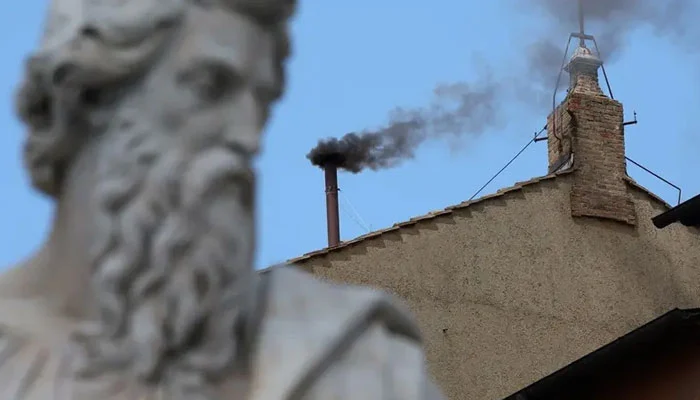Black smoke billowed from a chimney atop the Sistine Chapel on Thursday, indicating that the cardinals sequestered in a conclave have not yet selected a new pope to lead the Roman Catholic Church.
Thousands of faithful had gathered in St Peter’s Square to await the smoke’s emergence from the flue on the chapel’s roof, which occurred shortly before noon (1000 GMT), marking the conclusion of the morning voting session where two ballots are cast.
The 133 cardinals under the age of 80 commenced the highly ritualized and secret process on Wednesday, confined in complete isolation as they seek a successor to the late Pope Francis.
They burn their ballot papers and mix them with chemicals to produce signals about the proceedings — black smoke signifying no pope has been chosen, and white smoke announcing the election of a new pontiff.
The cardinals held an initial inconclusive vote on Wednesday evening. They are scheduled to conduct up to two more ballots on Thursday afternoon, with possible smoke signals anticipated sometime after 5:30 p.m. (1530 GMT).
The red-hatted “princes of the Church” will continue voting up to four times daily until a candidate secures a two-thirds majority.
“Francis was a great guy, down to earth, humble, and I hope they will choose someone just like him,” commented Tom Barbitta, a visitor from North Carolina, USA, vacationing in Italy with his wife Susan. They came to the square to witness the smoke.
Historically, no pope in modern times has been elected on the first ballot, making Wednesday’s black smoke widely expected. However, recent precedent suggests a successful outcome is possible as early as the second day.
Francis, the first pope from Latin America, was elected on the evening of the second day of the last conclave in 2013, a timeline mirrored by his predecessor, Benedict XVI, in 2005.
Italian Cardinal Giovanni Battista Re, 91 and thus ineligible to participate in the conclave, informed Italian reporters of his hope that the new pope would be elected by Thursday evening.
Geographic Diversity
A record 133 cardinals from 70 countries are participating in the 2025 ballot, an increase from the 115 cardinals representing 48 nations in the previous conclave — a growth reflecting Pope Francis’ efforts to broaden the global reach of the Church.
While no clear frontrunner has emerged, Italian Cardinal Pietro Parolin and Filipino Cardinal Luis Antonio Tagle are considered the leading contenders.
Should it become apparent that neither can achieve a victory, votes are expected to shift to other candidates, with electors potentially aligning based on geography, doctrinal affinity, or shared languages.
Other “papabili” — potential papal candidates in Italian — include France’s Jean-Marc Aveline, Hungary’s Peter Erdo, American Robert Prevost, Italy’s Pierbattista Pizzaballa, and Filipino Pablo Virgilio David.
During the conclave, cardinals are sequestered from the outside world and sworn to secrecy, their phones and computers confiscated. They are transported between the Sistine Chapel for voting and two Vatican guesthouses for sleeping and dining.
Prior to the conclave, some cardinals offered varying perspectives on the qualities they seek in the next pope. Pope Francis’ relatively liberal pontificate was marked by significant divisions between traditionalists and modernizers.
Some have advocated for continuity with his vision of greater openness and reform, while others yearn for a return to more traditional practices. Many have indicated a desire for a more predictable and measured papacy.



